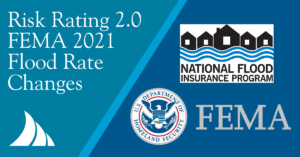 The new FEMA flood changes are on everyone’s mind these day, as the increases went into effect on October 1, 2021. Instead of relying on “flood zones” as a determination of your flood exposure, the new system is referred to as “Rating 2.0,” which is a single risk modeling system that takes into consideration area and proximity to harbor, replacement coverage, frame vs. block construction along with slab vs. pilings. Also considered is prior flood loss. Banks may use flood zones, but insurance companies are going by the new rating system. So what does all of this mean you ask? Well, if you have an existing flood policy your flood insurance will increase approximately 18% per year until you reach the figure FEMA has established as the target figure for your property. If you don’t have flood insurance then you will be subject to the new valuations FEMA has established. When buying a home it is important to find out in the beginning of your negotiations if the current seller is carrying flood insurance, as this will impact your investment in the home significantly. To give you a better understanding of the difference in buying a home where the seller is carrying flood insurance verses one where they aren’t, recently we had a buyer purchasing a home on a gulf access canal. They were quoted $6,700.00 to obtain flood insurance for the home. Thankfully, the seller’s insurance carrier said their policy could be assumed, which saved our buyer a significant amount of money as the seller was paying $1,080.00 for flood insurance. It is important to find out up front when negotiating the purchase of a home if the current homeowner is carrying flood insurance and if the policy can be assumed.
The new FEMA flood changes are on everyone’s mind these day, as the increases went into effect on October 1, 2021. Instead of relying on “flood zones” as a determination of your flood exposure, the new system is referred to as “Rating 2.0,” which is a single risk modeling system that takes into consideration area and proximity to harbor, replacement coverage, frame vs. block construction along with slab vs. pilings. Also considered is prior flood loss. Banks may use flood zones, but insurance companies are going by the new rating system. So what does all of this mean you ask? Well, if you have an existing flood policy your flood insurance will increase approximately 18% per year until you reach the figure FEMA has established as the target figure for your property. If you don’t have flood insurance then you will be subject to the new valuations FEMA has established. When buying a home it is important to find out in the beginning of your negotiations if the current seller is carrying flood insurance, as this will impact your investment in the home significantly. To give you a better understanding of the difference in buying a home where the seller is carrying flood insurance verses one where they aren’t, recently we had a buyer purchasing a home on a gulf access canal. They were quoted $6,700.00 to obtain flood insurance for the home. Thankfully, the seller’s insurance carrier said their policy could be assumed, which saved our buyer a significant amount of money as the seller was paying $1,080.00 for flood insurance. It is important to find out up front when negotiating the purchase of a home if the current homeowner is carrying flood insurance and if the policy can be assumed.Unfortunately, FEMA appears to be taking it out on Florida as Floridians have paid in 4 times the amount of claims that have been made. Where most of the country will see decreases in flood insurance rates, Florida will continue to see increases. Hopefully our state legislators will come up with a solution that will provide a more fair and balanced metric for calculating flood insurance rates.
The second major consideration for buyer and seller is the age of the roof. Many insurance brokers will share with you that in the years after Hurricane Irma struck Florida, there have been a bevy of insurance adjusters advertising and knocking on doors claiming they can get you a new roof. One such insurance broker shared with us that a home qualified for a new roof due to excessive hail damage. Not sure where in our area we had that kind of hail, but this is just one of the many questionable reasons how new roofs have been obtained. In order to protect themselves insurance companies are now putting limits on how long they will cover the roof before requiring a new one to be installed. Shingle roofs will have to be 15 years or newer as there are only 3 companies that will insure up to 20 years. Tile roofs, which most inspectors will tell you can last for 30 years or more, are now going to be required to be replaced after 20 years or perhaps slightly longer. Metal roofs will only be covered for 25-30 years and for older homes with more gradual pitch roofs that require a membrane type covering will now only be covered 10 years or less.
Whether you are the seller or buyer, flood insurance coverage and the age of roof are two major factors that you’ll have to consider when selling or buying a home.
Also, here is a link to find what Flood zone you lay in for Charlotte County: Find My Flood Zone
 While most people would like to talk about themselves, Gary and Gail have always put their clients first, and their diverse backgrounds have provided their clients an unparalleled level of service and knowledge throughout the past years.
While most people would like to talk about themselves, Gary and Gail have always put their clients first, and their diverse backgrounds have provided their clients an unparalleled level of service and knowledge throughout the past years.